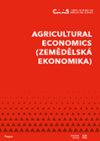生物资产报告:价值的增加是否由生物转化收入引起?
IF 1.8
4区 经济学
Q2 AGRICULTURAL ECONOMICS & POLICY
引用次数: 36
摘要
农村地区占27个欧盟(EU)成员国面积的91%,欧盟委员会(2007年)提到,农村地区是56%以上居民的家园,这使得农村发展政策非常重要。农业和林业作为农村地区经济多样化的平台,对欧盟农村地区的农田开发和自然资源管理具有根本的重要性。农业活动不同于经营单位为获得利润而进行的其他活动。农业活动与依赖于自然和环境条件的商业主体的其他活动相比,因此农业专业化与地理位置有狭窄的联系。另一个对农业生产(主要是植物生产)的范围和质量有重大影响的事实是,农业生产严重依赖天气条件和其他因素(病虫害等),而这些因素只能在有限的程度上受到人为因素的影响。另一个不可影响的因素是农业生产的生物特性——必须尊重生物特性,例如植被期、生产周期的长度等,这些特性通常重叠在一年的周期内。一些产品被农业企业自己进一步消费的事实也可以被认为是农业生产中的具体情况。农产品可以用于相关活动,如喂干草和谷物给牲畜或家禽,也可以由生产者直接销售。与代表稀缺资源的农田的狭窄联系被认为是一个限制因素。本文章由计算机程序翻译,如有差异,请以英文原文为准。
Biological assets reporting: Is the increase in value caused by the biological transformation revenue?
Rural areas represent 91% of the area of 27 European Union (EU) member states and home for more than 56% of their inhabitants as mentioned by the European Commission (2007), which makes the rural development policy very important. Agriculture and forestry have the fundamental importance for the exploitation of farmland and the administration of natural sources in the rural areas of the EU as the platform for the economic diversification of rural areas. Agricultural activity differs from other activities carried out by business units to achieve the profit. Agricultural activity is in comparison with other activities of business subjects dependent on the natural and environmental conditions, and therefore the agriculture specialization is narrowly connected with the geographical position. Another fact, which significantly influences the extent and quality of agricultural production, mainly in the case of plant production, represents the significant dependence on weather conditions and other factors (pests, diseases, etc.), which can be influenced by the action of the human factor only in a restricted extent. As another factor which cannot be influenced, there is considered the biological character of agricultural production – it is necessary to respect the biological characteristics, e.g. the vegetation period, the length of the production cycle, etc., which usually overlap the period of one year. The fact that some products are further consumed by the agricultural enterprise itself could be considered as specific in agricultural production as well. Farm products may be used in the related activities, such as feeding hay and grain to livestock or poultry, or they may be marketed directly by the producer. The narrow connection with farmland which represents a scarce source is considered as a restrictive factor.
求助全文
通过发布文献求助,成功后即可免费获取论文全文。
去求助
来源期刊

Agricultural Economics-Zemedelska Ekonomika
Agricultural Economics & Policy-
CiteScore
4.30
自引率
4.50%
发文量
47
审稿时长
30 weeks
期刊介绍:
An international peer-reviewed journal published under the auspices of the Czech Academy of Agricultural Sciences and financed by the Ministry of Agriculture of the Czech Republic. Published since 1954 (by 1999 under the title Zemědělská ekonomika).Thematic scope:
original scientific papers dealing with agricultural subjects from the sphere of economics, management, informatics, ecology, social economy and sociology. Since 1993 the papers continually treat problems which were published in the journal Sociologie venkova a zemědělství until now. An extensive scope of subjects in fact covers the whole of agribusiness, that means economic relations of suppliers and producers of inputs for agriculture and food industry, problems from the aspects of social economy and rural sociology and finally the economics of the population nutrition. Papers are published in English.
 求助内容:
求助内容: 应助结果提醒方式:
应助结果提醒方式:


